Strategic Planning Report: Dell and Health Focus Case Studies
VerifiedAdded on 2020/04/15
|12
|2352
|97
Report
AI Summary
This report presents a strategic planning analysis of Dell and Health Focus. It begins with a SWOT analysis of Dell, evaluating its strengths, weaknesses, opportunities, and threats. A PEST analysis then examines the political, economic, social, and technological factors influencing business operations in China, followed by a review of relevant legislation. The report also includes a discussion of a company's code of practice and applies Porter's Five Forces model to assess competitive dynamics. The second part of the report focuses on Health Focus, outlining a strategic plan with specific objectives, timeframes, responsible parties, and key performance indicators (KPIs) aimed at reducing customer churn, maximizing profit, developing employee skills, and achieving high customer satisfaction. Furthermore, it validates the company's mission and vision and identifies its core values. The report provides valuable insights into strategic planning and its application in real-world business scenarios, offering practical strategies for improving business performance. This report is available on Desklib, a platform providing AI-based study tools for students.
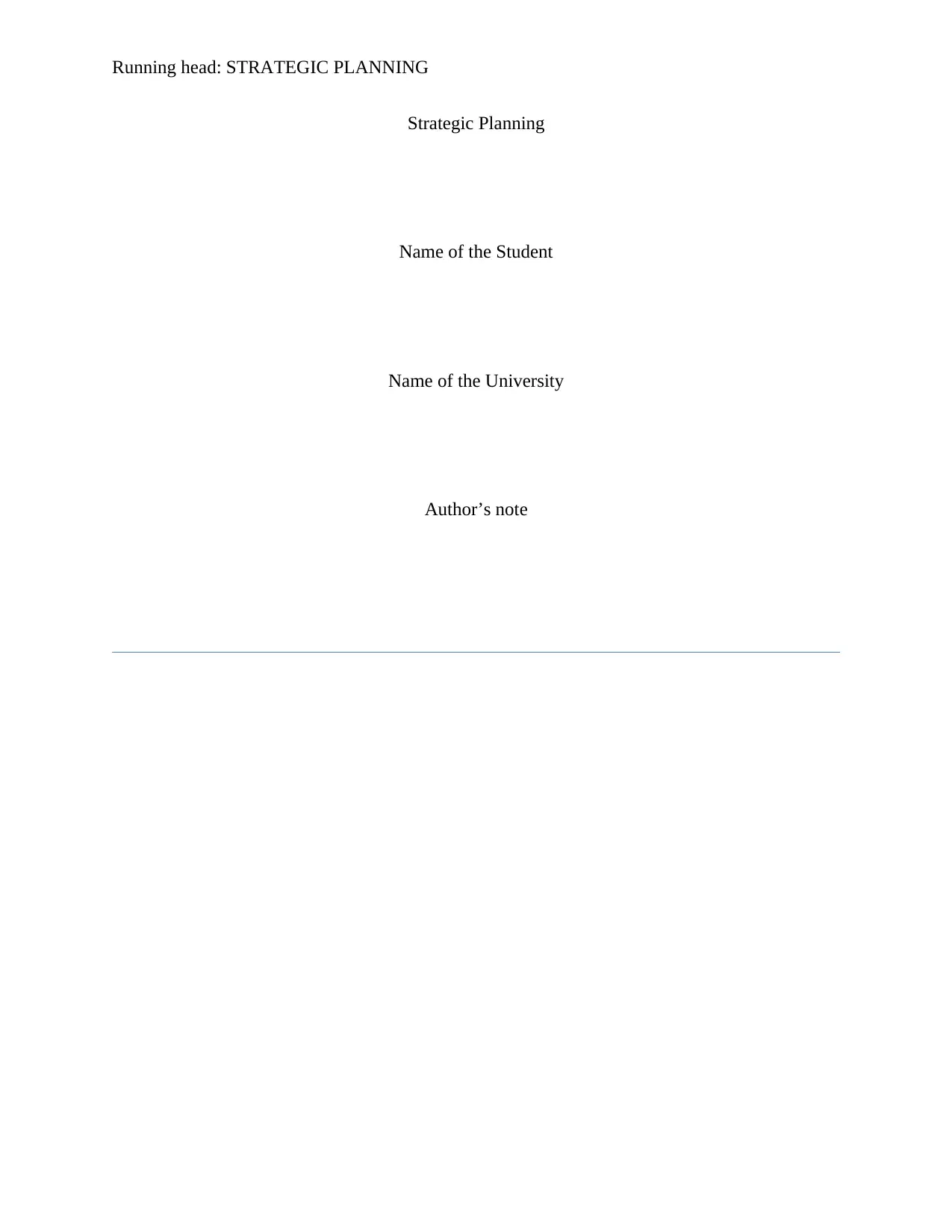
Running head: STRATEGIC PLANNING
Strategic Planning
Name of the Student
Name of the University
Author’s note
Strategic Planning
Name of the Student
Name of the University
Author’s note
Paraphrase This Document
Need a fresh take? Get an instant paraphrase of this document with our AI Paraphraser
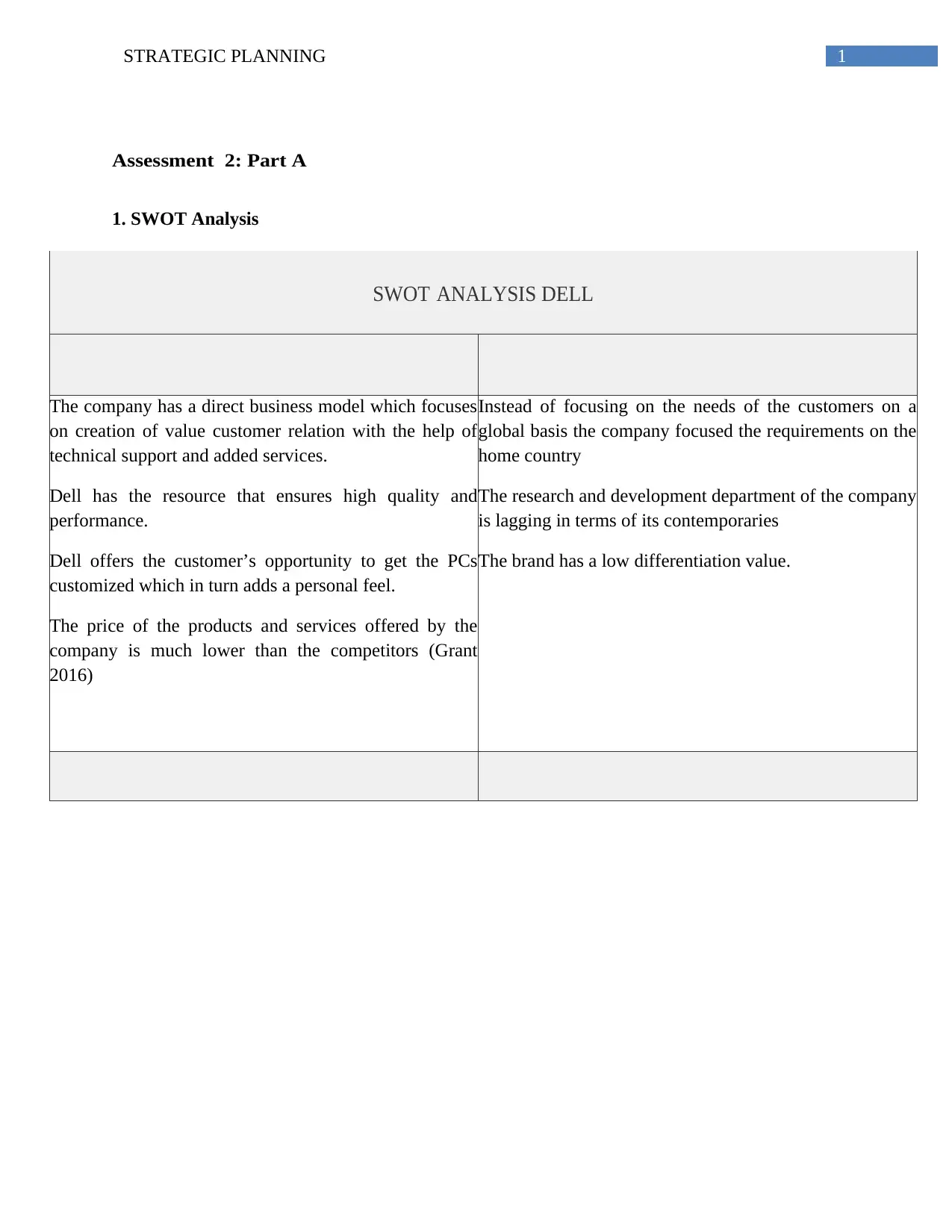
1STRATEGIC PLANNING
Assessment 2: Part A
1. SWOT Analysis
SWOT ANALYSIS DELL
The company has a direct business model which focuses
on creation of value customer relation with the help of
technical support and added services.
Dell has the resource that ensures high quality and
performance.
Dell offers the customer’s opportunity to get the PCs
customized which in turn adds a personal feel.
The price of the products and services offered by the
company is much lower than the competitors (Grant
2016)
Instead of focusing on the needs of the customers on a
global basis the company focused the requirements on the
home country
The research and development department of the company
is lagging in terms of its contemporaries
The brand has a low differentiation value.
Assessment 2: Part A
1. SWOT Analysis
SWOT ANALYSIS DELL
The company has a direct business model which focuses
on creation of value customer relation with the help of
technical support and added services.
Dell has the resource that ensures high quality and
performance.
Dell offers the customer’s opportunity to get the PCs
customized which in turn adds a personal feel.
The price of the products and services offered by the
company is much lower than the competitors (Grant
2016)
Instead of focusing on the needs of the customers on a
global basis the company focused the requirements on the
home country
The research and development department of the company
is lagging in terms of its contemporaries
The brand has a low differentiation value.
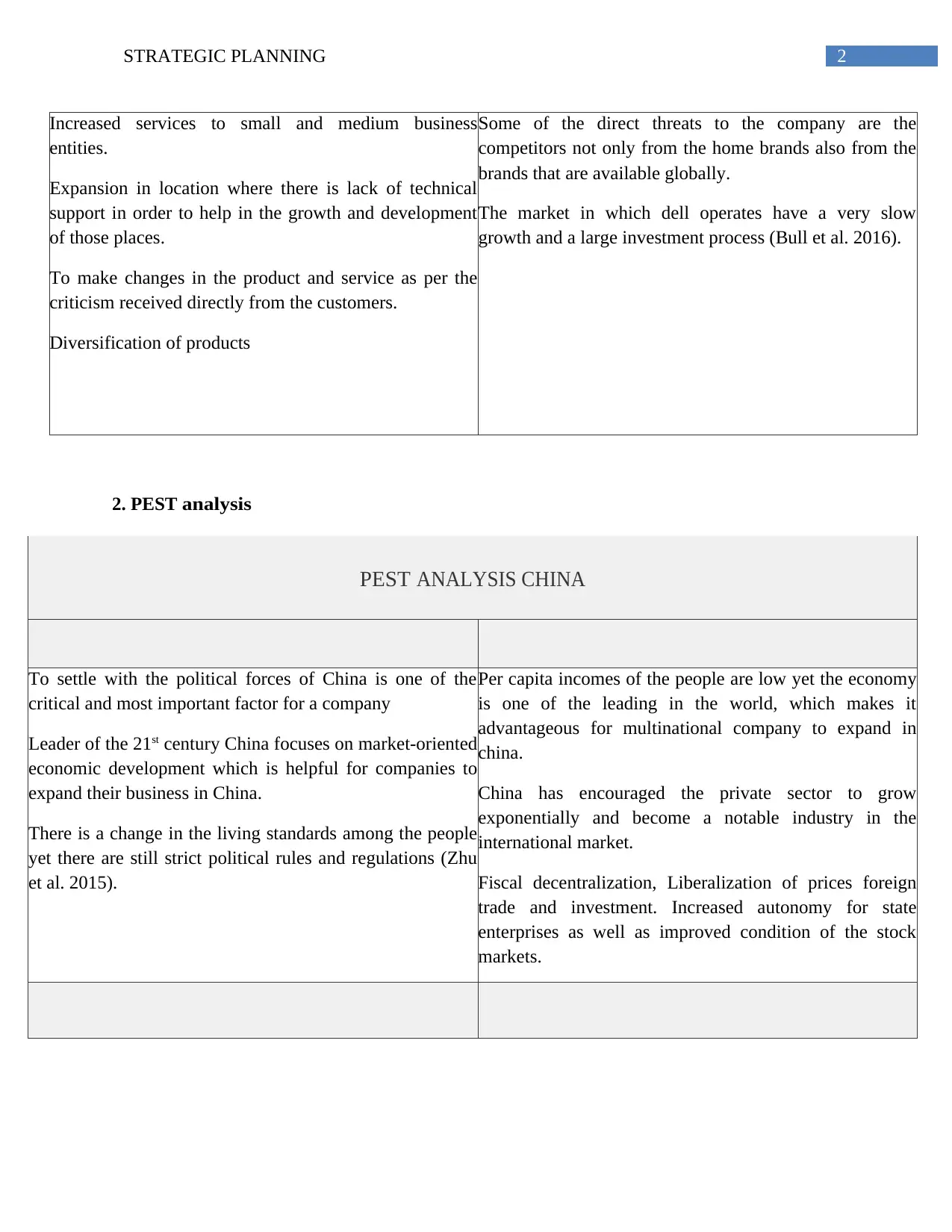
2STRATEGIC PLANNING
Increased services to small and medium business
entities.
Expansion in location where there is lack of technical
support in order to help in the growth and development
of those places.
To make changes in the product and service as per the
criticism received directly from the customers.
Diversification of products
Some of the direct threats to the company are the
competitors not only from the home brands also from the
brands that are available globally.
The market in which dell operates have a very slow
growth and a large investment process (Bull et al. 2016).
2. PEST analysis
PEST ANALYSIS CHINA
To settle with the political forces of China is one of the
critical and most important factor for a company
Leader of the 21st century China focuses on market-oriented
economic development which is helpful for companies to
expand their business in China.
There is a change in the living standards among the people
yet there are still strict political rules and regulations (Zhu
et al. 2015).
Per capita incomes of the people are low yet the economy
is one of the leading in the world, which makes it
advantageous for multinational company to expand in
china.
China has encouraged the private sector to grow
exponentially and become a notable industry in the
international market.
Fiscal decentralization, Liberalization of prices foreign
trade and investment. Increased autonomy for state
enterprises as well as improved condition of the stock
markets.
Increased services to small and medium business
entities.
Expansion in location where there is lack of technical
support in order to help in the growth and development
of those places.
To make changes in the product and service as per the
criticism received directly from the customers.
Diversification of products
Some of the direct threats to the company are the
competitors not only from the home brands also from the
brands that are available globally.
The market in which dell operates have a very slow
growth and a large investment process (Bull et al. 2016).
2. PEST analysis
PEST ANALYSIS CHINA
To settle with the political forces of China is one of the
critical and most important factor for a company
Leader of the 21st century China focuses on market-oriented
economic development which is helpful for companies to
expand their business in China.
There is a change in the living standards among the people
yet there are still strict political rules and regulations (Zhu
et al. 2015).
Per capita incomes of the people are low yet the economy
is one of the leading in the world, which makes it
advantageous for multinational company to expand in
china.
China has encouraged the private sector to grow
exponentially and become a notable industry in the
international market.
Fiscal decentralization, Liberalization of prices foreign
trade and investment. Increased autonomy for state
enterprises as well as improved condition of the stock
markets.
⊘ This is a preview!⊘
Do you want full access?
Subscribe today to unlock all pages.

Trusted by 1+ million students worldwide
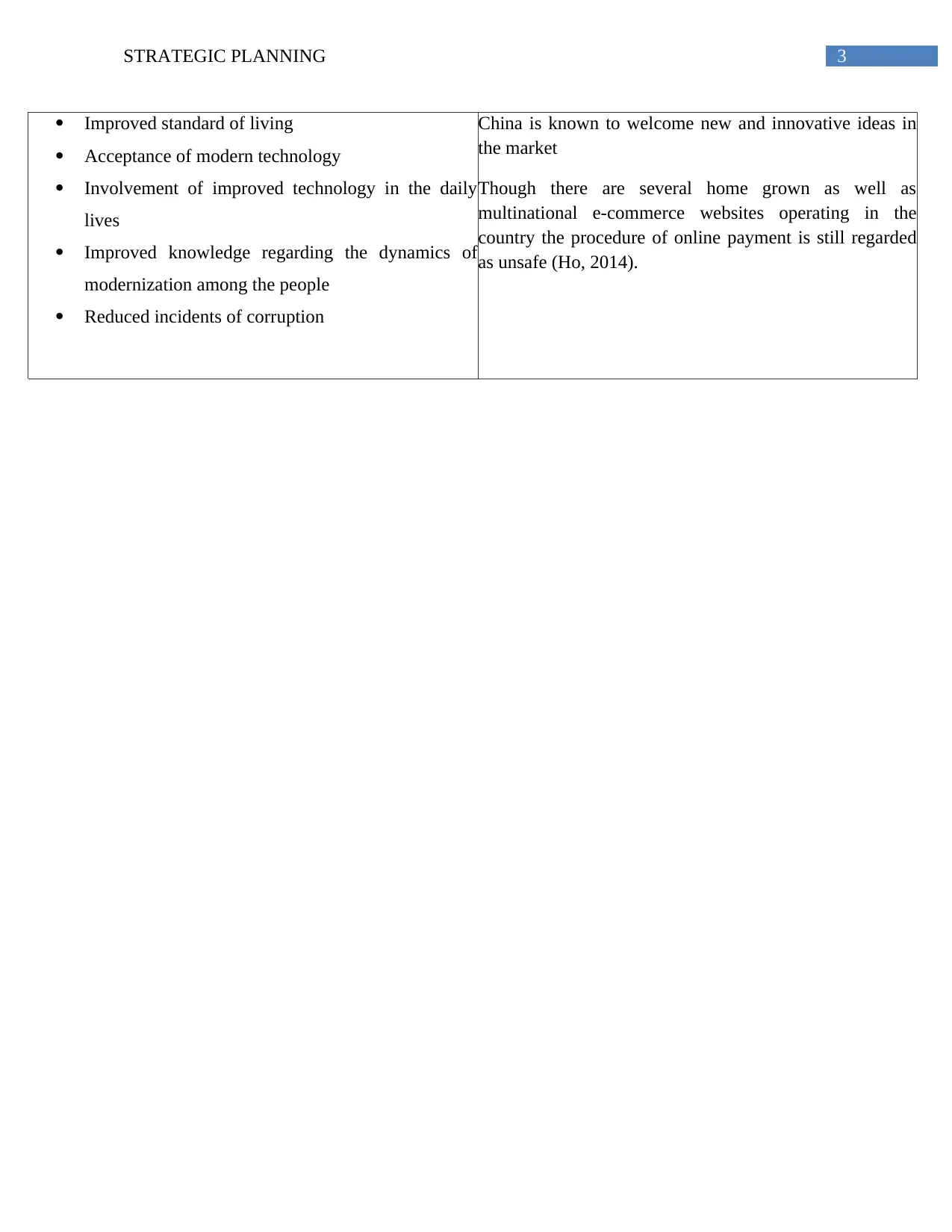
3STRATEGIC PLANNING
Improved standard of living
Acceptance of modern technology
Involvement of improved technology in the daily
lives
Improved knowledge regarding the dynamics of
modernization among the people
Reduced incidents of corruption
China is known to welcome new and innovative ideas in
the market
Though there are several home grown as well as
multinational e-commerce websites operating in the
country the procedure of online payment is still regarded
as unsafe (Ho, 2014).
Improved standard of living
Acceptance of modern technology
Involvement of improved technology in the daily
lives
Improved knowledge regarding the dynamics of
modernization among the people
Reduced incidents of corruption
China is known to welcome new and innovative ideas in
the market
Though there are several home grown as well as
multinational e-commerce websites operating in the
country the procedure of online payment is still regarded
as unsafe (Ho, 2014).
Paraphrase This Document
Need a fresh take? Get an instant paraphrase of this document with our AI Paraphraser
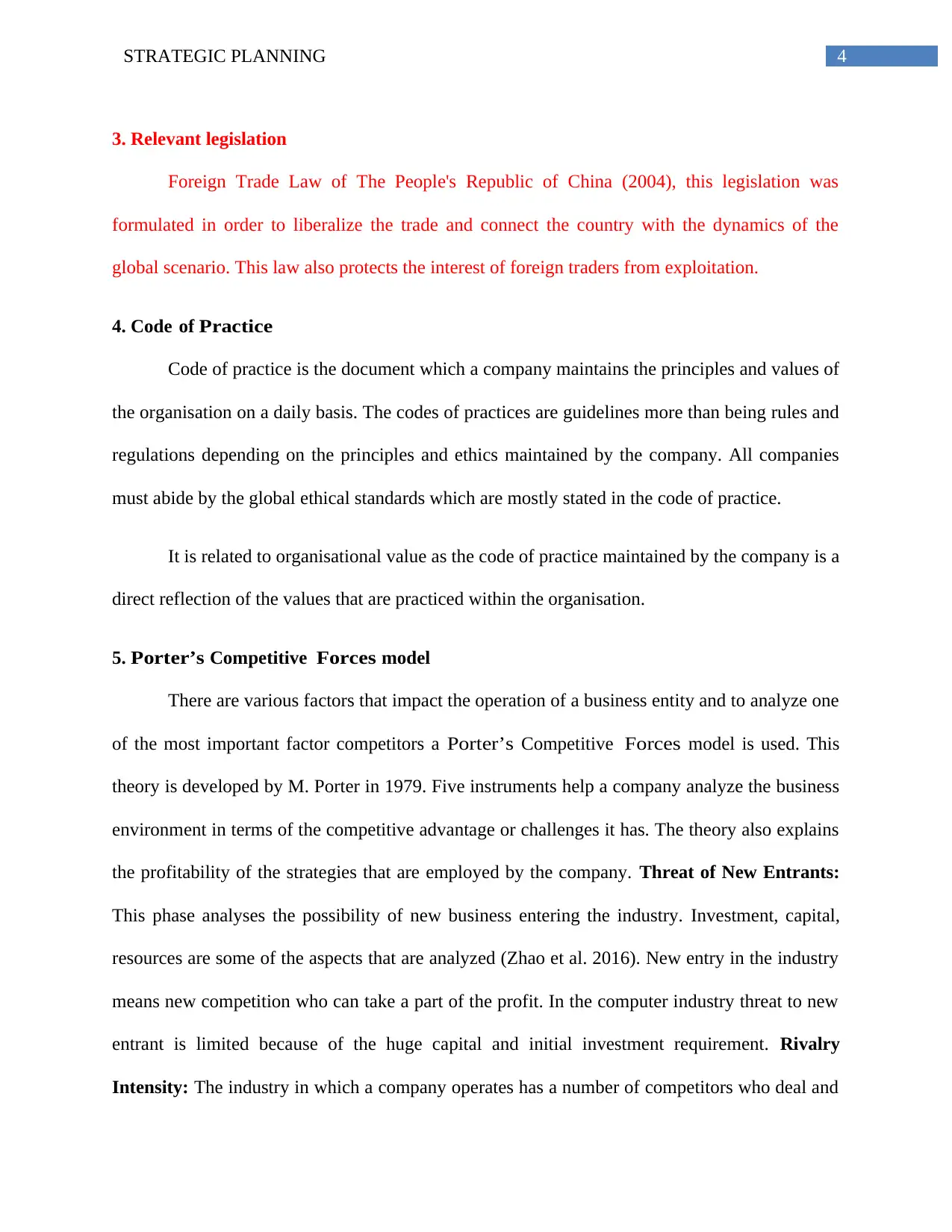
4STRATEGIC PLANNING
3. Relevant legislation
Foreign Trade Law of The People's Republic of China (2004), this legislation was
formulated in order to liberalize the trade and connect the country with the dynamics of the
global scenario. This law also protects the interest of foreign traders from exploitation.
4. Code of Practice
Code of practice is the document which a company maintains the principles and values of
the organisation on a daily basis. The codes of practices are guidelines more than being rules and
regulations depending on the principles and ethics maintained by the company. All companies
must abide by the global ethical standards which are mostly stated in the code of practice.
It is related to organisational value as the code of practice maintained by the company is a
direct reflection of the values that are practiced within the organisation.
5. Porter’s Competitive Forces model
There are various factors that impact the operation of a business entity and to analyze one
of the most important factor competitors a Porter’s Competitive Forces model is used. This
theory is developed by M. Porter in 1979. Five instruments help a company analyze the business
environment in terms of the competitive advantage or challenges it has. The theory also explains
the profitability of the strategies that are employed by the company. Threat of New Entrants:
This phase analyses the possibility of new business entering the industry. Investment, capital,
resources are some of the aspects that are analyzed (Zhao et al. 2016). New entry in the industry
means new competition who can take a part of the profit. In the computer industry threat to new
entrant is limited because of the huge capital and initial investment requirement. Rivalry
Intensity: The industry in which a company operates has a number of competitors who deal and
3. Relevant legislation
Foreign Trade Law of The People's Republic of China (2004), this legislation was
formulated in order to liberalize the trade and connect the country with the dynamics of the
global scenario. This law also protects the interest of foreign traders from exploitation.
4. Code of Practice
Code of practice is the document which a company maintains the principles and values of
the organisation on a daily basis. The codes of practices are guidelines more than being rules and
regulations depending on the principles and ethics maintained by the company. All companies
must abide by the global ethical standards which are mostly stated in the code of practice.
It is related to organisational value as the code of practice maintained by the company is a
direct reflection of the values that are practiced within the organisation.
5. Porter’s Competitive Forces model
There are various factors that impact the operation of a business entity and to analyze one
of the most important factor competitors a Porter’s Competitive Forces model is used. This
theory is developed by M. Porter in 1979. Five instruments help a company analyze the business
environment in terms of the competitive advantage or challenges it has. The theory also explains
the profitability of the strategies that are employed by the company. Threat of New Entrants:
This phase analyses the possibility of new business entering the industry. Investment, capital,
resources are some of the aspects that are analyzed (Zhao et al. 2016). New entry in the industry
means new competition who can take a part of the profit. In the computer industry threat to new
entrant is limited because of the huge capital and initial investment requirement. Rivalry
Intensity: The industry in which a company operates has a number of competitors who deal and
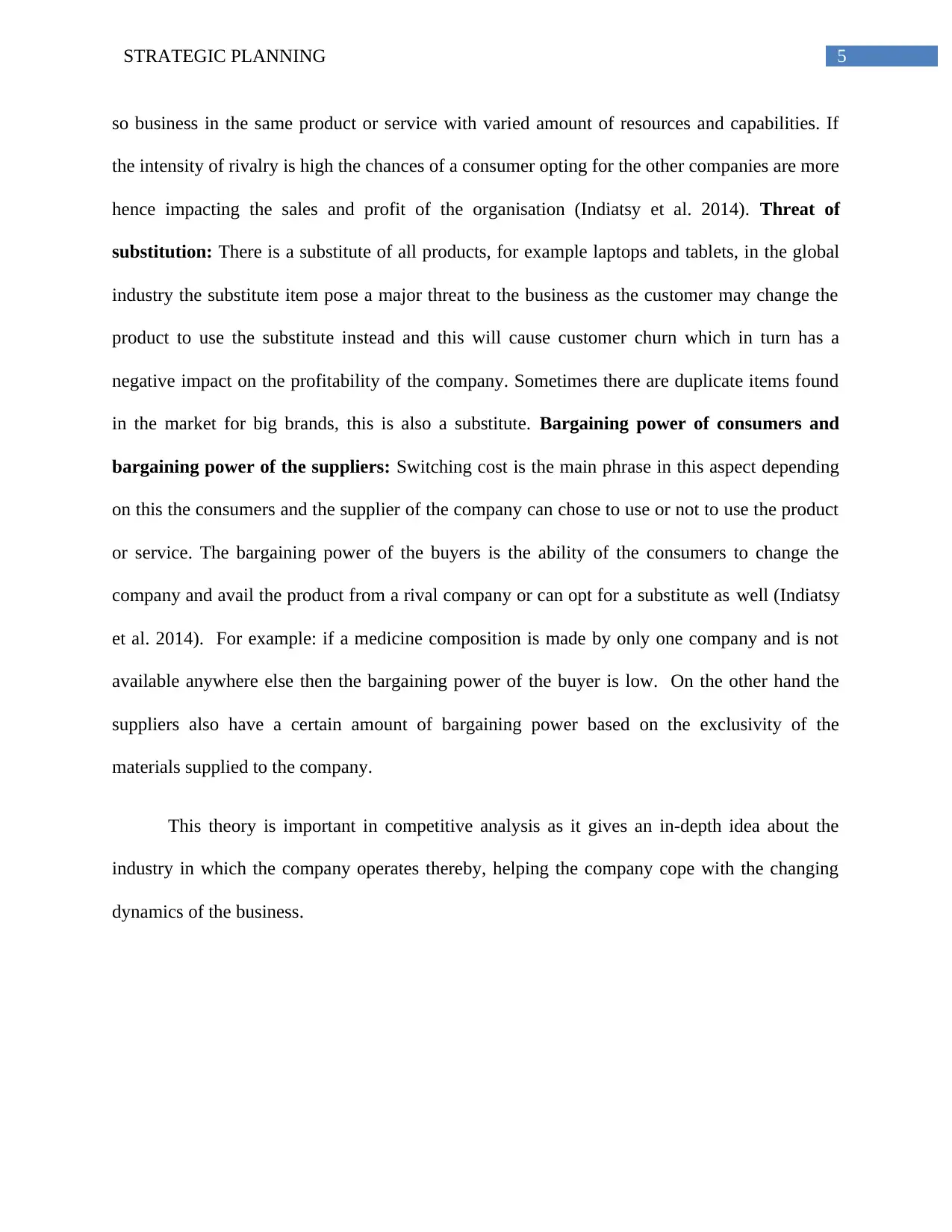
5STRATEGIC PLANNING
so business in the same product or service with varied amount of resources and capabilities. If
the intensity of rivalry is high the chances of a consumer opting for the other companies are more
hence impacting the sales and profit of the organisation (Indiatsy et al. 2014). Threat of
substitution: There is a substitute of all products, for example laptops and tablets, in the global
industry the substitute item pose a major threat to the business as the customer may change the
product to use the substitute instead and this will cause customer churn which in turn has a
negative impact on the profitability of the company. Sometimes there are duplicate items found
in the market for big brands, this is also a substitute. Bargaining power of consumers and
bargaining power of the suppliers: Switching cost is the main phrase in this aspect depending
on this the consumers and the supplier of the company can chose to use or not to use the product
or service. The bargaining power of the buyers is the ability of the consumers to change the
company and avail the product from a rival company or can opt for a substitute as well (Indiatsy
et al. 2014). For example: if a medicine composition is made by only one company and is not
available anywhere else then the bargaining power of the buyer is low. On the other hand the
suppliers also have a certain amount of bargaining power based on the exclusivity of the
materials supplied to the company.
This theory is important in competitive analysis as it gives an in-depth idea about the
industry in which the company operates thereby, helping the company cope with the changing
dynamics of the business.
so business in the same product or service with varied amount of resources and capabilities. If
the intensity of rivalry is high the chances of a consumer opting for the other companies are more
hence impacting the sales and profit of the organisation (Indiatsy et al. 2014). Threat of
substitution: There is a substitute of all products, for example laptops and tablets, in the global
industry the substitute item pose a major threat to the business as the customer may change the
product to use the substitute instead and this will cause customer churn which in turn has a
negative impact on the profitability of the company. Sometimes there are duplicate items found
in the market for big brands, this is also a substitute. Bargaining power of consumers and
bargaining power of the suppliers: Switching cost is the main phrase in this aspect depending
on this the consumers and the supplier of the company can chose to use or not to use the product
or service. The bargaining power of the buyers is the ability of the consumers to change the
company and avail the product from a rival company or can opt for a substitute as well (Indiatsy
et al. 2014). For example: if a medicine composition is made by only one company and is not
available anywhere else then the bargaining power of the buyer is low. On the other hand the
suppliers also have a certain amount of bargaining power based on the exclusivity of the
materials supplied to the company.
This theory is important in competitive analysis as it gives an in-depth idea about the
industry in which the company operates thereby, helping the company cope with the changing
dynamics of the business.
⊘ This is a preview!⊘
Do you want full access?
Subscribe today to unlock all pages.

Trusted by 1+ million students worldwide
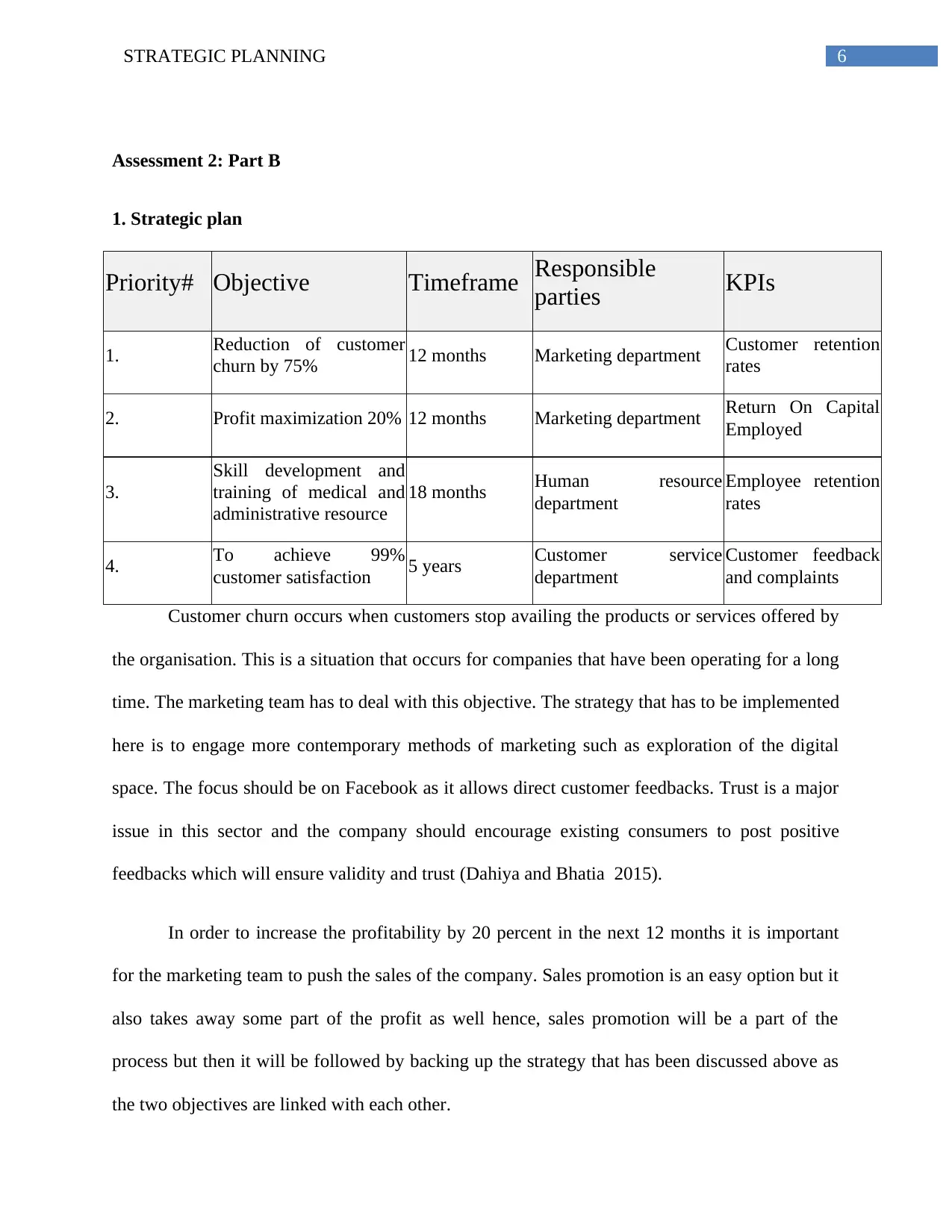
6STRATEGIC PLANNING
Assessment 2: Part B
1. Strategic plan
Priority# Objective Timeframe Responsible
parties KPIs
1. Reduction of customer
churn by 75% 12 months Marketing department Customer retention
rates
2. Profit maximization 20% 12 months Marketing department Return On Capital
Employed
3.
Skill development and
training of medical and
administrative resource
18 months Human resource
department
Employee retention
rates
4. To achieve 99%
customer satisfaction 5 years Customer service
department
Customer feedback
and complaints
Customer churn occurs when customers stop availing the products or services offered by
the organisation. This is a situation that occurs for companies that have been operating for a long
time. The marketing team has to deal with this objective. The strategy that has to be implemented
here is to engage more contemporary methods of marketing such as exploration of the digital
space. The focus should be on Facebook as it allows direct customer feedbacks. Trust is a major
issue in this sector and the company should encourage existing consumers to post positive
feedbacks which will ensure validity and trust (Dahiya and Bhatia 2015).
In order to increase the profitability by 20 percent in the next 12 months it is important
for the marketing team to push the sales of the company. Sales promotion is an easy option but it
also takes away some part of the profit as well hence, sales promotion will be a part of the
process but then it will be followed by backing up the strategy that has been discussed above as
the two objectives are linked with each other.
Assessment 2: Part B
1. Strategic plan
Priority# Objective Timeframe Responsible
parties KPIs
1. Reduction of customer
churn by 75% 12 months Marketing department Customer retention
rates
2. Profit maximization 20% 12 months Marketing department Return On Capital
Employed
3.
Skill development and
training of medical and
administrative resource
18 months Human resource
department
Employee retention
rates
4. To achieve 99%
customer satisfaction 5 years Customer service
department
Customer feedback
and complaints
Customer churn occurs when customers stop availing the products or services offered by
the organisation. This is a situation that occurs for companies that have been operating for a long
time. The marketing team has to deal with this objective. The strategy that has to be implemented
here is to engage more contemporary methods of marketing such as exploration of the digital
space. The focus should be on Facebook as it allows direct customer feedbacks. Trust is a major
issue in this sector and the company should encourage existing consumers to post positive
feedbacks which will ensure validity and trust (Dahiya and Bhatia 2015).
In order to increase the profitability by 20 percent in the next 12 months it is important
for the marketing team to push the sales of the company. Sales promotion is an easy option but it
also takes away some part of the profit as well hence, sales promotion will be a part of the
process but then it will be followed by backing up the strategy that has been discussed above as
the two objectives are linked with each other.
Paraphrase This Document
Need a fresh take? Get an instant paraphrase of this document with our AI Paraphraser
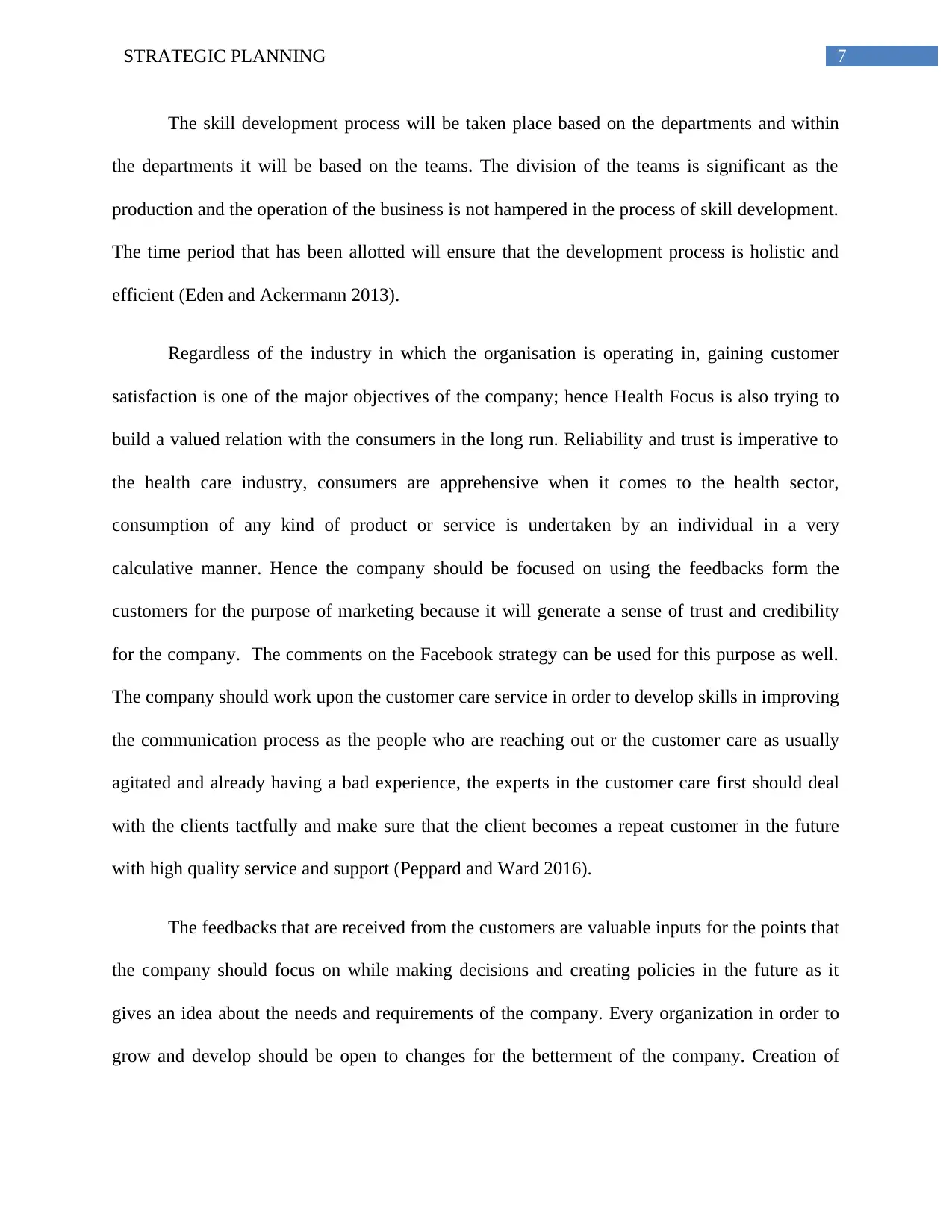
7STRATEGIC PLANNING
The skill development process will be taken place based on the departments and within
the departments it will be based on the teams. The division of the teams is significant as the
production and the operation of the business is not hampered in the process of skill development.
The time period that has been allotted will ensure that the development process is holistic and
efficient (Eden and Ackermann 2013).
Regardless of the industry in which the organisation is operating in, gaining customer
satisfaction is one of the major objectives of the company; hence Health Focus is also trying to
build a valued relation with the consumers in the long run. Reliability and trust is imperative to
the health care industry, consumers are apprehensive when it comes to the health sector,
consumption of any kind of product or service is undertaken by an individual in a very
calculative manner. Hence the company should be focused on using the feedbacks form the
customers for the purpose of marketing because it will generate a sense of trust and credibility
for the company. The comments on the Facebook strategy can be used for this purpose as well.
The company should work upon the customer care service in order to develop skills in improving
the communication process as the people who are reaching out or the customer care as usually
agitated and already having a bad experience, the experts in the customer care first should deal
with the clients tactfully and make sure that the client becomes a repeat customer in the future
with high quality service and support (Peppard and Ward 2016).
The feedbacks that are received from the customers are valuable inputs for the points that
the company should focus on while making decisions and creating policies in the future as it
gives an idea about the needs and requirements of the company. Every organization in order to
grow and develop should be open to changes for the betterment of the company. Creation of
The skill development process will be taken place based on the departments and within
the departments it will be based on the teams. The division of the teams is significant as the
production and the operation of the business is not hampered in the process of skill development.
The time period that has been allotted will ensure that the development process is holistic and
efficient (Eden and Ackermann 2013).
Regardless of the industry in which the organisation is operating in, gaining customer
satisfaction is one of the major objectives of the company; hence Health Focus is also trying to
build a valued relation with the consumers in the long run. Reliability and trust is imperative to
the health care industry, consumers are apprehensive when it comes to the health sector,
consumption of any kind of product or service is undertaken by an individual in a very
calculative manner. Hence the company should be focused on using the feedbacks form the
customers for the purpose of marketing because it will generate a sense of trust and credibility
for the company. The comments on the Facebook strategy can be used for this purpose as well.
The company should work upon the customer care service in order to develop skills in improving
the communication process as the people who are reaching out or the customer care as usually
agitated and already having a bad experience, the experts in the customer care first should deal
with the clients tactfully and make sure that the client becomes a repeat customer in the future
with high quality service and support (Peppard and Ward 2016).
The feedbacks that are received from the customers are valuable inputs for the points that
the company should focus on while making decisions and creating policies in the future as it
gives an idea about the needs and requirements of the company. Every organization in order to
grow and develop should be open to changes for the betterment of the company. Creation of
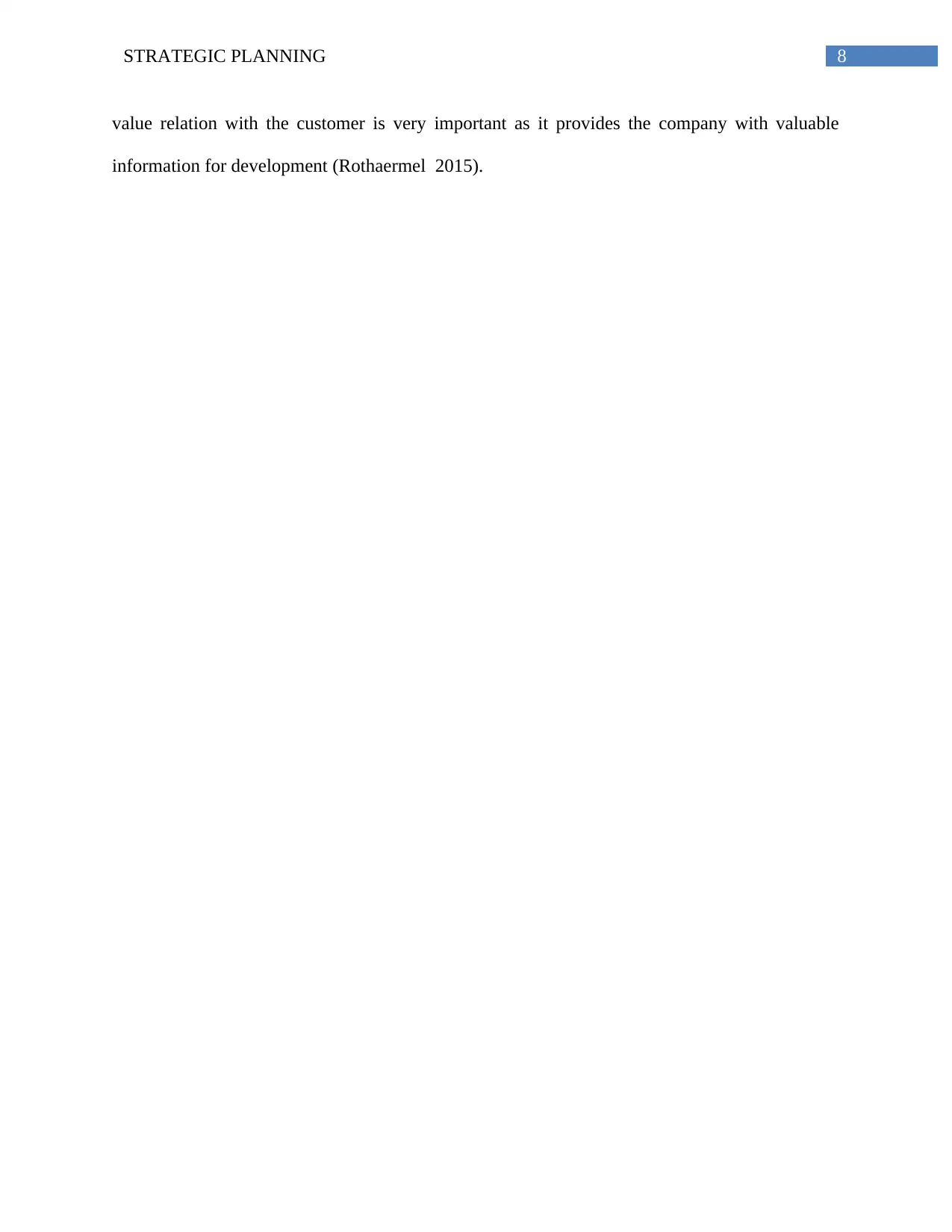
8STRATEGIC PLANNING
value relation with the customer is very important as it provides the company with valuable
information for development (Rothaermel 2015).
value relation with the customer is very important as it provides the company with valuable
information for development (Rothaermel 2015).
⊘ This is a preview!⊘
Do you want full access?
Subscribe today to unlock all pages.

Trusted by 1+ million students worldwide
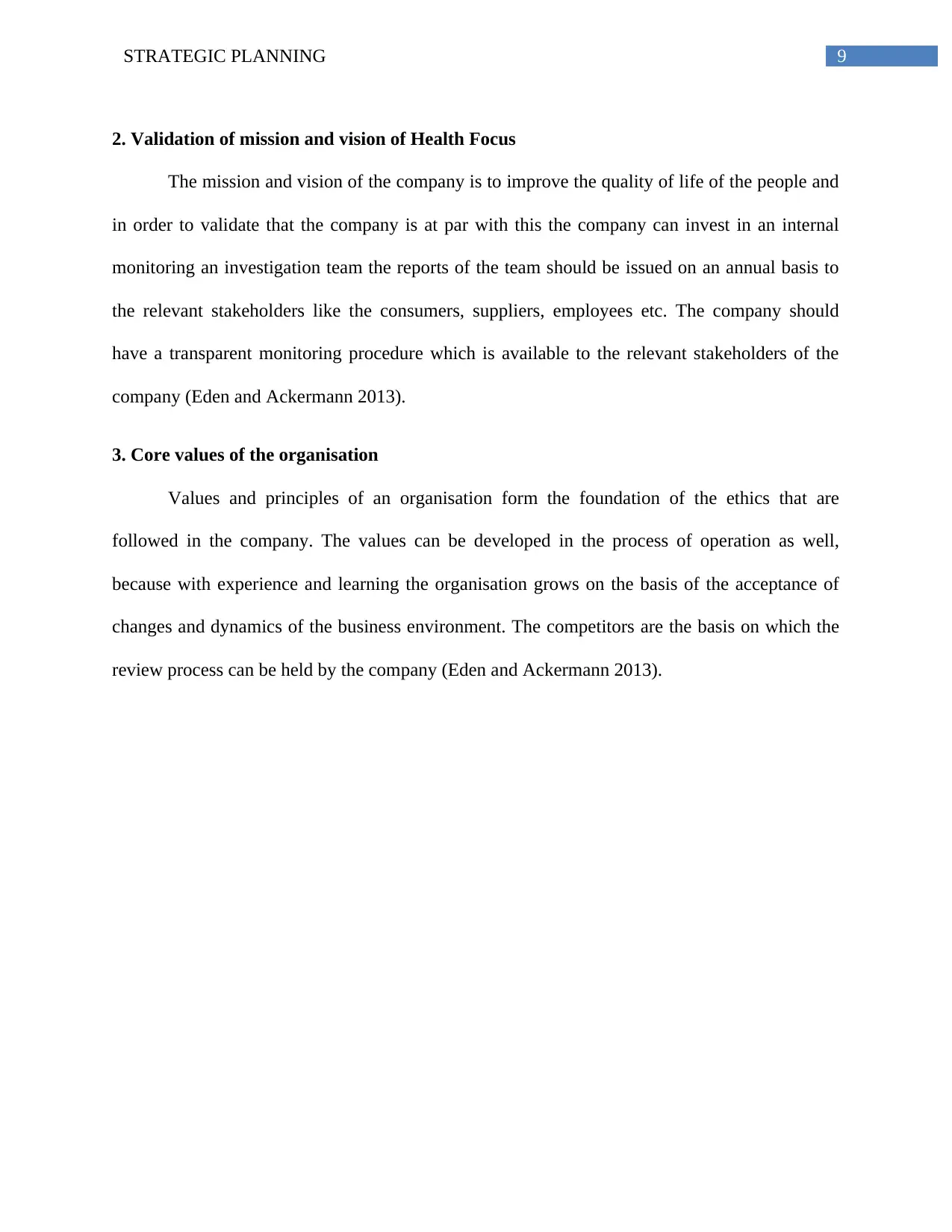
9STRATEGIC PLANNING
2. Validation of mission and vision of Health Focus
The mission and vision of the company is to improve the quality of life of the people and
in order to validate that the company is at par with this the company can invest in an internal
monitoring an investigation team the reports of the team should be issued on an annual basis to
the relevant stakeholders like the consumers, suppliers, employees etc. The company should
have a transparent monitoring procedure which is available to the relevant stakeholders of the
company (Eden and Ackermann 2013).
3. Core values of the organisation
Values and principles of an organisation form the foundation of the ethics that are
followed in the company. The values can be developed in the process of operation as well,
because with experience and learning the organisation grows on the basis of the acceptance of
changes and dynamics of the business environment. The competitors are the basis on which the
review process can be held by the company (Eden and Ackermann 2013).
2. Validation of mission and vision of Health Focus
The mission and vision of the company is to improve the quality of life of the people and
in order to validate that the company is at par with this the company can invest in an internal
monitoring an investigation team the reports of the team should be issued on an annual basis to
the relevant stakeholders like the consumers, suppliers, employees etc. The company should
have a transparent monitoring procedure which is available to the relevant stakeholders of the
company (Eden and Ackermann 2013).
3. Core values of the organisation
Values and principles of an organisation form the foundation of the ethics that are
followed in the company. The values can be developed in the process of operation as well,
because with experience and learning the organisation grows on the basis of the acceptance of
changes and dynamics of the business environment. The competitors are the basis on which the
review process can be held by the company (Eden and Ackermann 2013).
Paraphrase This Document
Need a fresh take? Get an instant paraphrase of this document with our AI Paraphraser
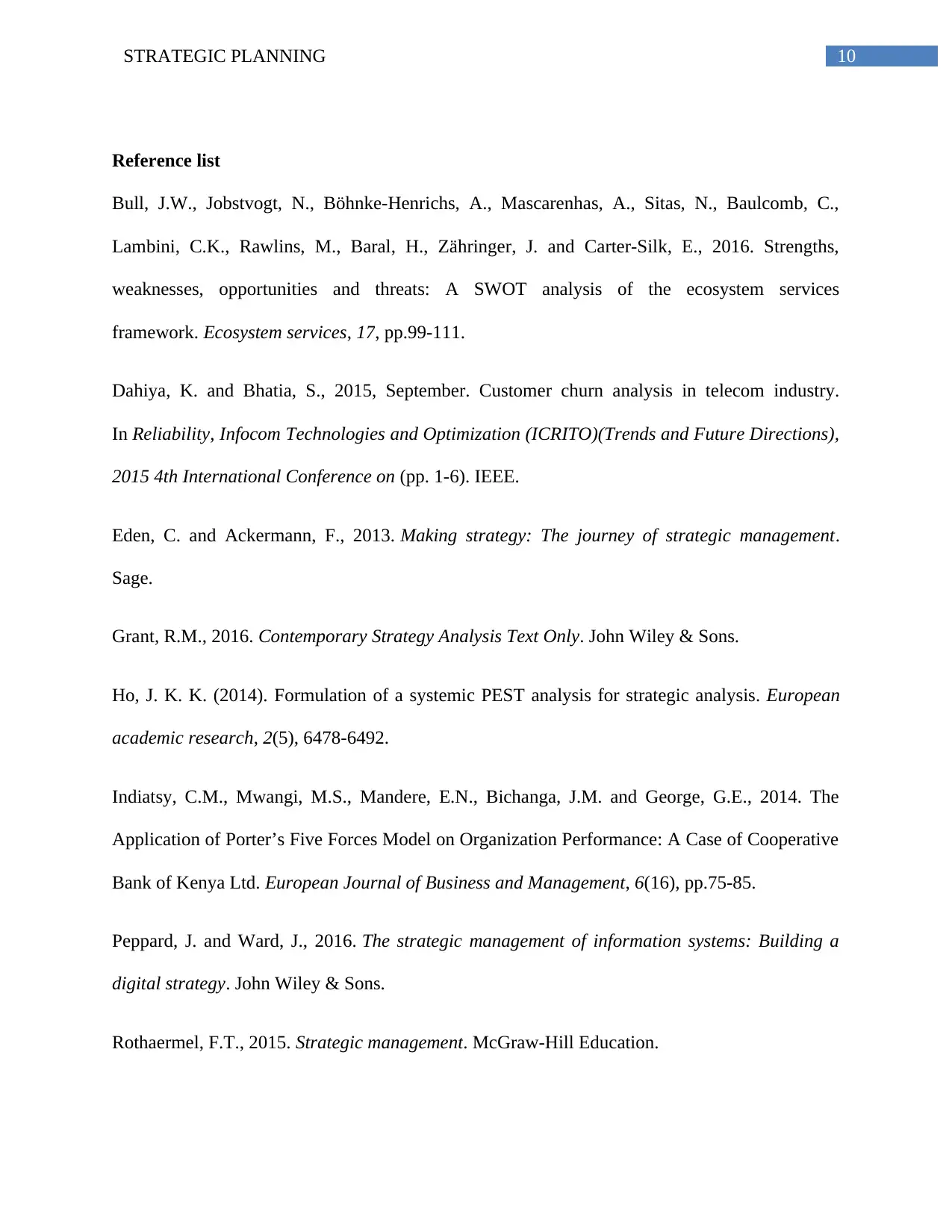
10STRATEGIC PLANNING
Reference list
Bull, J.W., Jobstvogt, N., Böhnke-Henrichs, A., Mascarenhas, A., Sitas, N., Baulcomb, C.,
Lambini, C.K., Rawlins, M., Baral, H., Zähringer, J. and Carter-Silk, E., 2016. Strengths,
weaknesses, opportunities and threats: A SWOT analysis of the ecosystem services
framework. Ecosystem services, 17, pp.99-111.
Dahiya, K. and Bhatia, S., 2015, September. Customer churn analysis in telecom industry.
In Reliability, Infocom Technologies and Optimization (ICRITO)(Trends and Future Directions),
2015 4th International Conference on (pp. 1-6). IEEE.
Eden, C. and Ackermann, F., 2013. Making strategy: The journey of strategic management.
Sage.
Grant, R.M., 2016. Contemporary Strategy Analysis Text Only. John Wiley & Sons.
Ho, J. K. K. (2014). Formulation of a systemic PEST analysis for strategic analysis. European
academic research, 2(5), 6478-6492.
Indiatsy, C.M., Mwangi, M.S., Mandere, E.N., Bichanga, J.M. and George, G.E., 2014. The
Application of Porter’s Five Forces Model on Organization Performance: A Case of Cooperative
Bank of Kenya Ltd. European Journal of Business and Management, 6(16), pp.75-85.
Peppard, J. and Ward, J., 2016. The strategic management of information systems: Building a
digital strategy. John Wiley & Sons.
Rothaermel, F.T., 2015. Strategic management. McGraw-Hill Education.
Reference list
Bull, J.W., Jobstvogt, N., Böhnke-Henrichs, A., Mascarenhas, A., Sitas, N., Baulcomb, C.,
Lambini, C.K., Rawlins, M., Baral, H., Zähringer, J. and Carter-Silk, E., 2016. Strengths,
weaknesses, opportunities and threats: A SWOT analysis of the ecosystem services
framework. Ecosystem services, 17, pp.99-111.
Dahiya, K. and Bhatia, S., 2015, September. Customer churn analysis in telecom industry.
In Reliability, Infocom Technologies and Optimization (ICRITO)(Trends and Future Directions),
2015 4th International Conference on (pp. 1-6). IEEE.
Eden, C. and Ackermann, F., 2013. Making strategy: The journey of strategic management.
Sage.
Grant, R.M., 2016. Contemporary Strategy Analysis Text Only. John Wiley & Sons.
Ho, J. K. K. (2014). Formulation of a systemic PEST analysis for strategic analysis. European
academic research, 2(5), 6478-6492.
Indiatsy, C.M., Mwangi, M.S., Mandere, E.N., Bichanga, J.M. and George, G.E., 2014. The
Application of Porter’s Five Forces Model on Organization Performance: A Case of Cooperative
Bank of Kenya Ltd. European Journal of Business and Management, 6(16), pp.75-85.
Peppard, J. and Ward, J., 2016. The strategic management of information systems: Building a
digital strategy. John Wiley & Sons.
Rothaermel, F.T., 2015. Strategic management. McGraw-Hill Education.
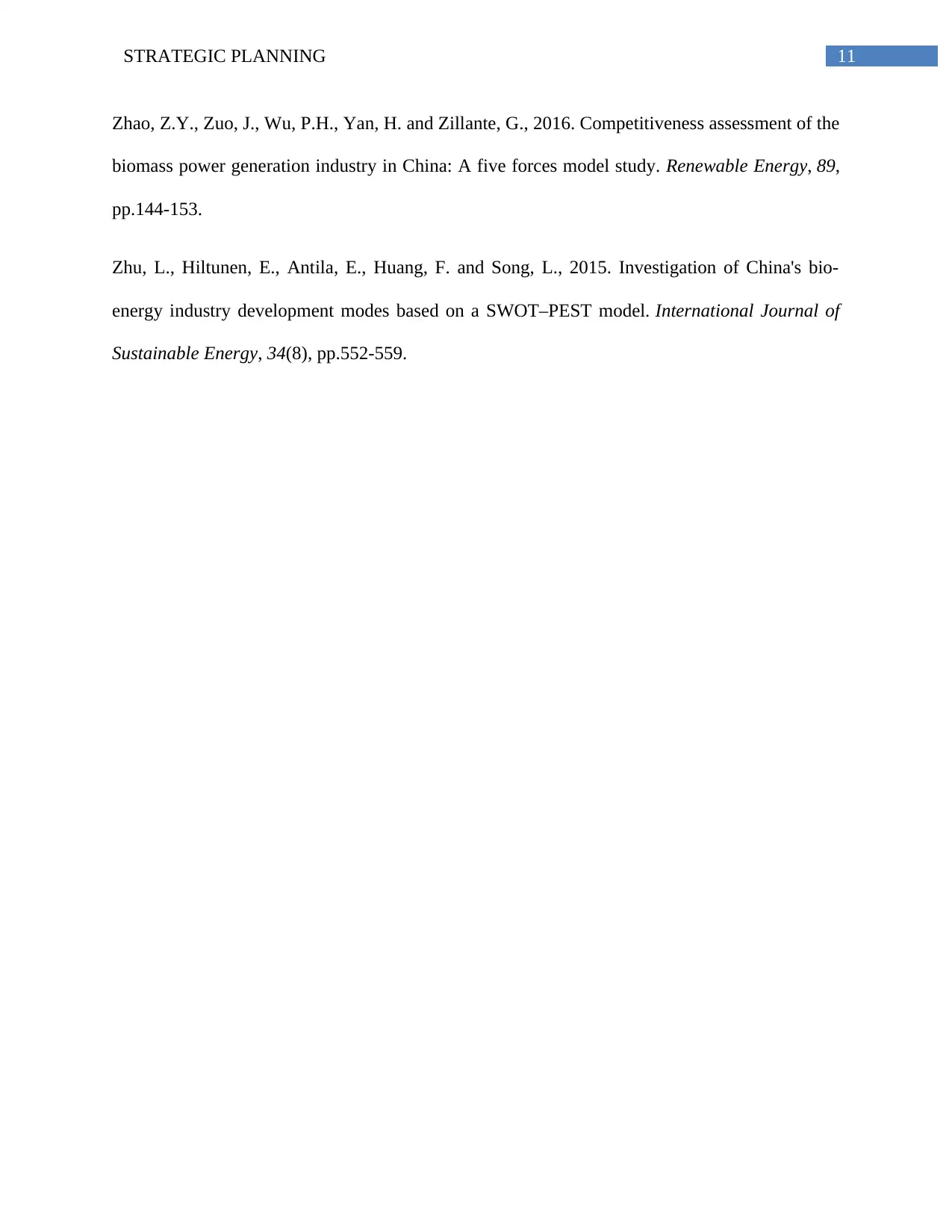
11STRATEGIC PLANNING
Zhao, Z.Y., Zuo, J., Wu, P.H., Yan, H. and Zillante, G., 2016. Competitiveness assessment of the
biomass power generation industry in China: A five forces model study. Renewable Energy, 89,
pp.144-153.
Zhu, L., Hiltunen, E., Antila, E., Huang, F. and Song, L., 2015. Investigation of China's bio-
energy industry development modes based on a SWOT–PEST model. International Journal of
Sustainable Energy, 34(8), pp.552-559.
Zhao, Z.Y., Zuo, J., Wu, P.H., Yan, H. and Zillante, G., 2016. Competitiveness assessment of the
biomass power generation industry in China: A five forces model study. Renewable Energy, 89,
pp.144-153.
Zhu, L., Hiltunen, E., Antila, E., Huang, F. and Song, L., 2015. Investigation of China's bio-
energy industry development modes based on a SWOT–PEST model. International Journal of
Sustainable Energy, 34(8), pp.552-559.
⊘ This is a preview!⊘
Do you want full access?
Subscribe today to unlock all pages.

Trusted by 1+ million students worldwide
1 out of 12
Related Documents
Your All-in-One AI-Powered Toolkit for Academic Success.
+13062052269
info@desklib.com
Available 24*7 on WhatsApp / Email
![[object Object]](/_next/static/media/star-bottom.7253800d.svg)
Unlock your academic potential
Copyright © 2020–2025 A2Z Services. All Rights Reserved. Developed and managed by ZUCOL.





